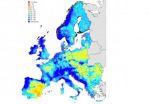(Press-News.org) DURHAM, N.H. – A parking lot at the edge of the University of New Hampshire campus has contributed important research to an emerging concern for the environment and human health.
The research, detailed in a recent feature article in the journal Environmental Science & Technology, has found that one type of pavement sealcoat, common on driveways and parking lots throughout the nation, has significant health and ecosystem implications. Alison Watts, research assistant professor of civil engineering at UNH, is a co-author of the article "Coal-Tar-Based Pavement Sealcoat and PAHs: Implications for the Environment, Human Health, and Stormwater Management."
Sealcoat, a black surface applied over asphalt pavements that is marketed as improving appearance and enhancing pavement longevity, is made of either an asphalt emulsion or a refined coal-tar pitch emulsion. Although the two sealcoats are similar in appearance and cost, concentrations of PAHs (polycyclic aromatic hydrocarbons), a group of organic compounds known to be detrimental to human and ecosystem health, are about 1,000 times higher in coal-tar-based sealcoats than those based in asphalt.
Conducting side-by-side studies of coal-tar-based sealcoated and nonsealcoated parking lots at UNH's West Edge lot, Watts, a researcher with the UNH Stormwater Center, found that the soil at the edge of the sealcoated lot contained "orders of magnitude higher concentrations" – several hundred parts per million (ppm) from the sealcoated lot versus less than 10 ppm from the lot without sealcoating -- of PAHs. What's more, soil samples taken three years after the initial application of sealcoat remained high in PAHs.
The problem may be even more pronounced in New England: PAHs move into the environment as the sealcoat wears off, a process that snowplows seem to accelerate. "We think it's likely that we have even a more severe problem here in the Northeast, because the sealcoat wears off more rapidly," Watts says.
The journal article discusses the potential human health effects of coal-tar-based sealcoat, which is associated with elevated concentrations of PAHs in house dust, soil, air, water, and sediment. It cites a recent study that found that children living in homes adjacent to pavement with coal-tar-based sealcoat were likely exposed to about 14-fold higher doses of PAHs than those living adjacent to unsealed pavement. Studies at the Columbia Center for Children's Health have found that PAHs in homes can contribute to delays in cognitive development, asthma and other respiratory symptoms, obesity and metabolic disorders, or changes at the molecular level that could increase children's cancer risk.
Unlike many complex environmental issues, however, this one has a relatively painless fix: avoid coal-tar-based sealcoats in favor of asphalt-based ones, or no sealcoat at all. "Consumers generally can't tell the difference," Watts says. And voluntary shifts in the market are making that choice easier, she says, noting that retailers Home Depot and Lowes no longer sell coal-tar-based sealcoat, and several commercial sealcoaters use only asphalt-based sealcoat.
"The crux of this issue is that it's a fairly simply choice we can make that will be beneficial to the environment and to human health without significant impact to the users," Watts says.
Moving beyond the Stormwater Center's test parking lots, Watts will next study the effect of coal-tar-based sealcoats in raising the PAH concentration in the sediments of New Hampshire's Great Bay. "PAHs are increasing in Great Bay sediments, and in fact in sediments across the country," she says. While there are other sources of PAHs in the Great Bay -- including old gas plants, car exhaust, and woodstove smoke -- she wonders if sealcoat may be the culprit.
###
Watts's work has been funded by New Hampshire Sea Grant and the Environmental Protection Agency; the upcoming Great Bay study received funding from the U.S. Geological Society. Learn more about PAHs in sealcoat from this brochure co-produced by NH Sea Grant and the UNH Stormwater Center: http://www.unh.edu/unhsc/sites/unh.edu.unhsc/files/UNHSC%20Seagrant%20sealcoat%20fact%20sheet.pdf.
The feature article can be found here: http://tx.usgs.gov/coring/pubs/MahlerESTsealcoatFeature2012.pdf
The University of New Hampshire, founded in 1866, is a world-class public research university with the feel of a New England liberal arts college. A land, sea, and space-grant university, UNH is the state's flagship public institution, enrolling 12,200 undergraduate and 2,300 graduate students.
Photograph available to download: http://unh.edu/news/cj_nr/2012/mar/bp14ceps.jpg
Caption: University of New Hampshire research on coal-tar-based sealcoat has contributed to growing concern about the substance's impact on human and environmental health.
Credit: UNH Stormwater Center
END
Using radio and infrared telescopes, astronomers have obtained a first tantalizing look at a crucial early stage in star formation. The new observations promise to help scientists understand the early stages of a sequence of events through which a giant cloud of gas and dust collapses into dense cores that, in turn, form new stars.
The scientists studied a giant cloud about 770 light-years from Earth in the constellation Perseus. They used the European Space Agency's Herschel Space Observatory and the National Science Foundation's Green Bank Telescope (GBT) to make detailed ...
CHAMPAIGN, Ill. — Those motivated to actively change bad habits may be setting themselves up for failure, a new study suggests.
The study, described in an article in the journal Motivation and Emotion, found that people primed with words suggesting action were more likely than others to make impulsive decisions that undermined their long-term goals. In contrast, those primed to "rest," to "stop" or to be inactive found it easier to avoid impulsive decisions.
"Popular views of self-control maintain that individuals should 'exert' willpower, 'fight' temptations, 'overcome' ...
Copenhagen, Denmark – Important progress has been achieved towards including genomic-level information in the data made freely available through GBIF.
Successful alignment of informatics standards for recording species occurrences and gene-sequence descriptions has opened up new possibilities for integrating the different types of data.
The mapping of three standards was completed at a GBIF-led workshop in Oxford, United Kingdom bringing together experts from Europe, the United States, China and Japan.
A testing programme will shortly begin to bring data from several ...
NEW YORK, March 14, 2012 – A new research survey conducted by the Center for the Study of Asian American Health at NYU Langone Medical Center shows the Bangladeshi community in New York City experiences numerous barriers to diabetes care because of limited English proficiency and lack of diabetes awareness. The study, published in the March 2012 issue of the American Journal of Public Health, also found the Bangladeshi community has an interest in participating in community health programs for diabetes prevention and care.
"We need to improve diabetes prevention, and ...
WASHINGTON, March 14, 2012 — The latest episode in the American Chemical Society's (ACS) award-winning "Global Challenges/Chemistry Solutions" podcast series describes the development of a new test that could help track down and prosecute terrorists.
Amid concerns about the threat of terrorist attacks, scientists have been seeking better protection for the U.S. and other nations. One such team has developed a technique that could help authorities catch terrorists and put them out of business. A report on the development appeared in ACS' journal Analytical Chemistry, ...
Scientists at Johannes Gutenberg University Mainz (JGU) in Germany have developed a new method of observing individual proteins. Detailed knowledge of the dynamics of proteins is necessary in order to understand the related biological processes that occur on the molecular level. To date, this information has been obtained by means of labeling proteins with fluorescent substances, but unfortunately this changes the proteins under investigation and thus influences the biological processes that are to be observed. "Our method allows live tracking of individual proteins without ...
The reputation developed by Jamaica Blue Mountain Coffee has made it one of the most desirable and expensive coffees in the world. Blue Mountain coffee from Jamaica is known to have a mild and balanced flavor and lack the bitterness often found in lesser coffees. J. Martinez & Company is one of few companies given the right to import Jamaica Blue Mountain coffee.
Blue Mountain Coffee is protected by a global certification mark, meaning that steps have been taken to ensure that only authentic Blue Mountain coffee, grown in a specific region of the Blue Mountains of ...
A new assessment of available water resources, published today by the Joint Research Centre (JRC), reveals that large areas in Spain and Eastern Europe have on average less than 200 mm freshwater available every year while the demand for water is three to ten times higher. The report 'Current Water Resources in Europe and Africa' shows variations in yearly freshwater generation from 10 mm to over 500 mm for Europe and from less than 0.1 mm to over 500 mm for Africa. The report outlines existing uncertainties and points to further research efforts needed for improved water ...
CORAL GABLES, FL (March 14, 2012)--Convincing speeches are central to campaigning for elected office, but do our voices affect how we select our leaders? A newly-published paper in Proceedings of the Royal Society B: Biological Sciences shows that men and women vote for male and female candidates with lower-pitched voices. Men and women with lower voices were also found to be perceived as more competent, stronger, and more trustworthy. Each of these attributes is known to influence voters.
"Our study asks how voice pitch influences electability, and to my knowledge is ...
NEW YORK (March 14, 2012) -- Nationwide ambulance use by patients suffering from a stroke has not changed since the mid-1990s, even though effective stroke treatments are now available. In a study published in this week's Journal of the American Medical Association (JAMA), researchers at NewYork-Presbyterian Hospital/Weill Cornell Medical Center found that the number of stroke victims transported via ambulance has remained relatively static over the years, highlighting the need for more education about stroke symptoms and the importance of early intervention.
The study, ...

